Looking for some bucket-list travel ideas? You can't go wrong with these incredible natural wonders of the world.
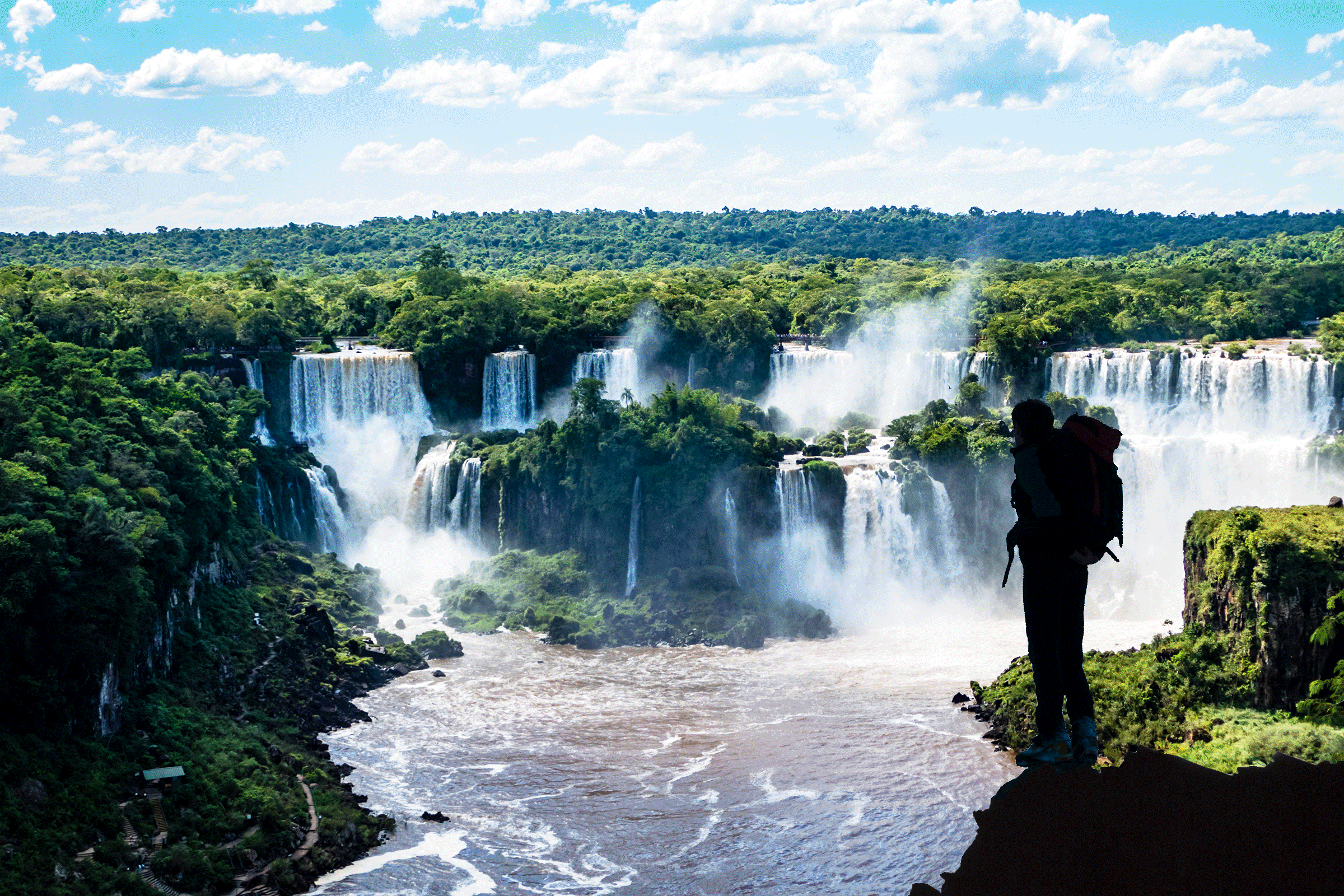
25 Natural Wonders of the World You Can Still Visit


Poás Volcano, Costa Rica
One of the most visited volcanoes in Costa Rica is also one of the oldest—it actually helped form the Central Valley, a defining feature of the country. Sitting more than 8,884 feet above sea level, Poás Volcano has been active for hundreds of years, though its last major eruption was in 1910. Visitors can still get up close and personal (with a reservation, that is). If you’re lucky enough to get a view of the crater, it’s breathtaking, but views may be obstructed by clouds due to volatile weather conditions. Dress warm and bring an umbrella, as precipitation is common at the top of the mountain.
The volcano is about an hour’s drive from the center of San José. And you’ll want to leave some wiggle room in your schedule so you can sample fresh strawberries at the fruit stands along the way, or go on a tour at Doka Estate to learn how coffee is made.

Mount Otemanu, Bora Bora
Bora Bora rose to prominence during World War II when soldiers were stationed on the island. Mount Otemanu is the island’s main attraction, and it has an interesting history: You can still see cannons that were installed to defend the island from Japanese attack. The massive mountain, which stands 2,385 feet above a stunning lagoon, is the perfect backdrop for dreamy Tahitian sunsets. A few of the luxury resorts offer great views of the mountain, including the St. Regis Bora Bora and the Conrad Bora Bora Nui, which have become hot spots for honeymooners.
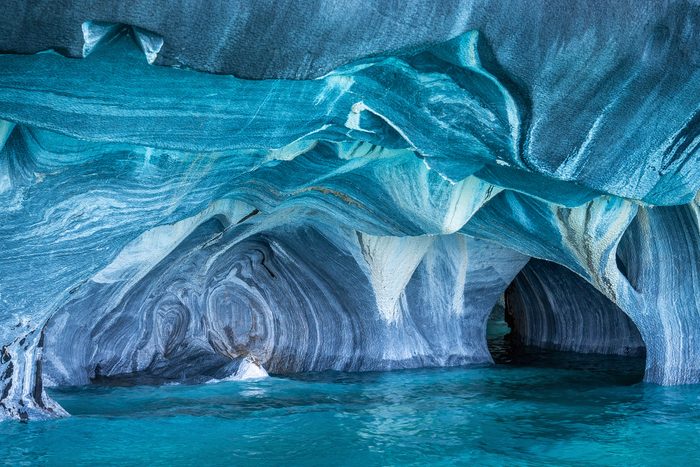
Marble Chapels, Chile
The Capillas de Mármol, or Marble Chapels, are a must-see when visiting the Patagonia region of Chile. These stunning caves are located in the middle of General Carrera Lake, which makes them accessible only by boat. One of the more remote natural wonders on this list, the iridescent Marble Chapels are actually calcium carbonate formations resulting from 6,000 years of wind and water slapping the rocks. The colors and arches inside the cave are mesmerizing, and even amateur photographers will have a field day here. The best time to visit is in the austral summer, from December to March, when the intensity of the blue waters is intensified by the sun.

Yosemite National Park, United States
One of California’s crown jewels, Yosemite National Park is an outdoor playground for nature enthusiasts. The protected park spans approximately 1,200 square miles, and it features towering sequoias, dramatic waterfalls, beautiful mountain ranges and sheer granite towers. Besides Half Dome and El Capitan, Yosemite is also home to Yosemite Falls—one of the world’s tallest waterfalls at 2,425 feet. May or June is the best time to see the waterfalls; September is also an ideal time to visit because of pleasant weather and fewer crowds.

Great Barrier Reef, Australia
One of the world’s greatest spectacles also happens to be one of the most vulnerable. Whether you choose to view this global treasure from a helicopter, or go scuba diving to enjoy close encounters with more than 1,500 species of tropical fish, it’s hard not to notice the direct impact of climate change. Warmer temperatures have led to significant amounts of coral bleaching, and farming pollution has caused starfish to feed off the precious coral. If the damage continues on the same trajectory, more than 90 percent of the living coral will erode within the next decade.

Haleakala National Park, United States
The Hawaiian island of Maui is world-famous for its magnificent beaches, fresh cuisine, burnt-orange sunsets and beautiful landscapes—all reasons why Maui is the best Hawaiian island. And the top of the dormant volcano at Haleakala National Park is one of its most epic spots. At just over 10,000 feet above sea level and spanning 30,000-plus acres of land, Haleakala offers plenty of scenic vistas, sparkling waterfalls and sightings of endangered species like the nēnē, the state bird. An important note if you want to hike to the crater at sunrise: You have to make a reservation in advance. There is also a fee to park your car, but it’s valid for three days, in case one visit just wasn’t enough.

Grand Canyon, United States
Arizona has no shortage of majestic mountains and sweeping vistas, but the Grand Canyon is hands down one of the most diverse geological wonders in the state—and the world. The visual grandeur of this UNESCO World Heritage Site and all-American natural wonder is characterized by several horizontal layers of rock formations that are nearly two billion years old. Visitors have several options to experience the beauty here: Adventure seekers can enjoy an aerial view from a helicopter ride through the canyons, or go whitewater rafting down the Colorado River (which is not for the faint of heart). For an easy hiking trail, head to the north rim to avoid large crowds, and check out the Cape Royal Trail—a flat, well-paved path that’s popular for sunrise and sunset views.

Cappadocia, Turkey
Imagine colorful hot air balloons against a magical landscape of rugged cliffs, valleys and minaret-like towers carved into the rocks. It’s hard to believe this place is real, but it is, and it’s in Turkey! The Anatolia region of Cappadocia is filled with rich history and culture, including the 40 identified underground cities and the Göreme Open Air Museum, a UNESCO World Heritage Site and one of the most visited sites in Cappadocia. For a good vantage point overlooking the landscape of this natural wonder, check out Uçhisar Castle—or drift during sunrise in one of the hot air balloons.

Blue Grotto, Malta
Malta is a beautiful Mediterranean island between Sicily and the North African coast. The island is known for year-round warm weather, ancient cities, dazzling beaches and, of course, the Blue Grotto: a series of caves that form high arches along the southern coast of the island. On a clear day, you can see the fluorescent colors reflected on the cave, a phenomenon caused by the underwater flora. Try to book a boat tour early in the morning when the sea is calm, the sun is bright and there are fewer crowds.

Banff National Park, Canada
The Rocky Mountains are a popular destination in Canada for a reason. If you visit between July and September, you’ll be rewarded with turquoise lakes, scenic mountain views and plenty of wildlife. The summer months allow for some of the best hiking and wildflower sightings of the year, but they also mean peak tourist season. September may be an even better time to visit, since the crowds fade, the leaves start to change color and the snow-capped mountains begin to appear in the distance. Biking is another fun way to explore the mountains around Banff, which boast more than 220 miles of cycling trails.
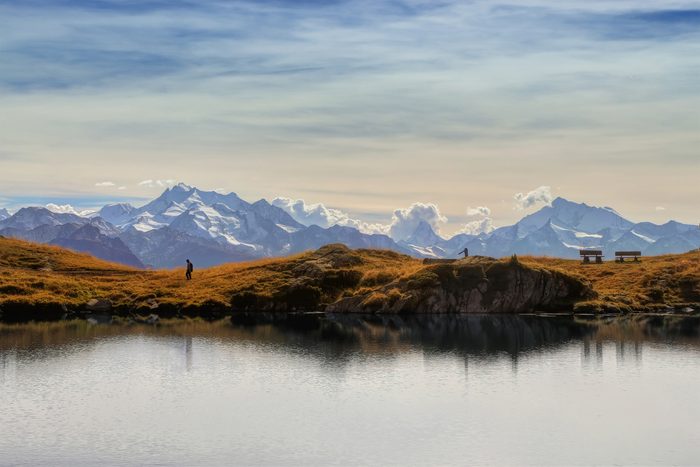
Blausee Lake, Switzerland
Blausee is a small, enchanting lake in the Kander Valley in Switzerland that gets its name from its vibrant crystal-blue color (Blausee means “blue lake”). The lake is surrounded by a stunning national park with towering pine trees, a boutique hotel and an organic trout farm. You can visit during the summer when the bright turquoise water is glimmering against the verdant backdrop, or the winter, when the snow-covered pine trees look like a Bob Ross painting—it’s idyllic year-round. Just know that there is an entrance fee, and dogs are allowed in the park on a leash.

Waitaki Whitestone Geopark, New Zealand
It’s hard to pick just one natural wonder in New Zealand, but Waitaki Whitestone Geopark tops the list. With picturesque rolling green hills, scenic cycling trails and an abundance of wildlife, this park just may be the most gorgeous outdoor wonderland you’ll ever experience. Walk, bike or drive through the park, and as you do, be on the lookout for unique rock formations. FYI, this New Zealand gem won’t be flying under the radar for much longer because it’s now New Zealand’s first UNESCO Global Geopark.

Galápagos Islands, Ecuador
The Galápagos Islands are a group of 19 large islands in Ecuador with a unique ecosystem and diverse range of endemic marine life and species. You’ll find the island’s namesake giant tortoise, sea iguanas, penguins and sea lions, to name a few. Watch the tortoises in their natural habitat at the El Chato Tortoise Reserve, snorkel with sea animals or spot exotic birds. For a challenging activity on land, check out many of the lava trails near the volcanoes. Bartolomé is probably the most iconic island—and the most visited. Hike more than 300 steps to the summit and soak up jaw-dropping views of Pinnacle Rock.

Stromboli, Italy
Yep, that delicious Italian dish takes its name from an actual place—a small volcanic island just north of Sicily. Its 3,000-foot-high active volcano, nicknamed the “Lighthouse of the Mediterranean,” has had lava flowing out for years. The most impressive sightings are at night, and the best way to see the volcano is on a boat tour. There are no cars, buses or trains on the island (only small motorbikes and three-wheeled vehicles known as Ape cars), and flashlights are recommended if you plan to walk around at night because there are no street lights.

Iguazú Falls, Argentina
Split between Argentina and Brazil, these famous falls are all drama and all beauty, all the time. They’re located in Iguazú National Park, a subtropical rainforest that offers many different vantage points of the waterfalls. Book a boat ride and see them up close as you sail through the Lower Iguazú River, or walk through the park—but either way, expect to get soaked!
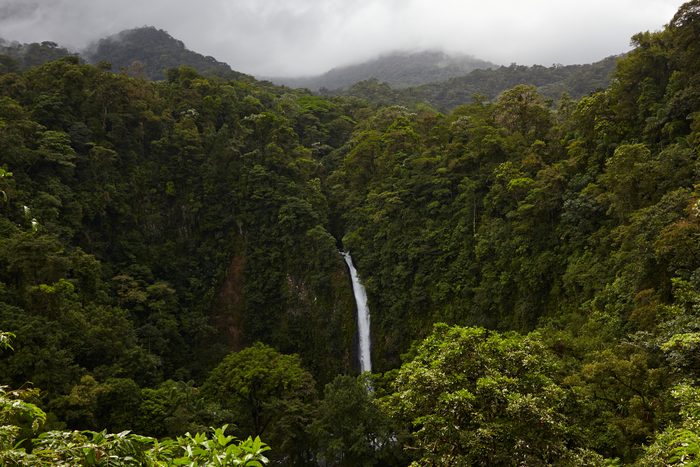
La Fortuna Waterfall, Costa Rica
A trip to Costa Rica isn’t complete without a visit to at least one waterfall. Dozens of thundering waterfalls are tucked away in tropical rainforests, or you might find a jaw-dropping set of falls as you’re driving down an unassuming road. La Fortuna is one of the more popular waterfalls on the island because it’s located near Arenal Volcano National Park. Both natural wonders are easy to access and can be visited on one adventure-filled day. If you’re heading to La Fortuna, your legs will get a good workout—it’s more than 500 steps down to the base. Don’t forget to wear comfortable shoes!

Great Blue Hole, Belize
This massive sinkhole is part of the Belize Barrier Reef, one of the most pristine reef ecosystems in the western hemisphere, and it’s a favorite spot for serious divers because of its incredible marine diversity. It’s also home to several shark species. Translation: It’s not for the faint of heart, but if you’re an experienced diver, you won’t want to miss it. While you’re in Belize, make sure to check out Ambergris Caye, the largest island in the country, and Bird Island, one of the smallest (and least crowded).

Dead Sea, Israel
The Dead Sea (also known as the Salt Sea), located about an hour away from Jerusalem, is estimated to be three million years old. It’s a top bucket-list destination, and for good reason—there’s nothing in the world like floating on the Dead Sea. The saline water has such a high density that it keeps swimmers afloat. People with skin conditions especially love to visit, as they can lather the mud on their body, and the mineral-rich saltwater is said to have healing benefits. Just make sure to avoid shaving one to two days prior to your visit because the salt will sting any cuts. (You shouldn’t stick your face underwater, either.)
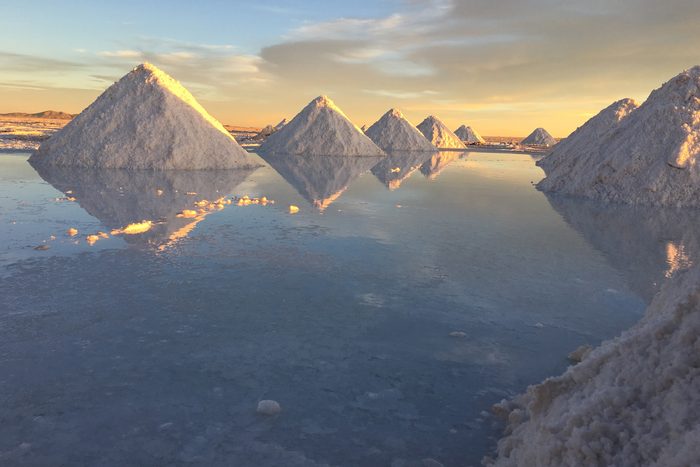
Salar de Uyuni, Bolivia
Also known as the Salt Flats, this extraordinary attraction is the world’s largest salt flat, a natural phenomenon resulting from dried-up prehistoric lakes. June to August is the dry season, so more tourists visit during this time. But December to April is less crowded and amazing in a whole different way: When the rain hits the salt flats, it causes a glass- or mirror-like effect, which looks really cool in photos. If you visit, keep in mind that the high-altitude flats are nearly 12,000 feet above sea level, so you may experience altitude sickness if you haven’t given yourself a few days to acclimate in town first.

Padjelanta National Park, Sweden
Sweden tops the list as one of the most sustainable countries in the world, and with so much natural beauty, it’s easy to see why. The country’s largest national park, Padjelanta National Park, is adjacent to the Norwegian border, and it’s a peaceful mountain escape where the Wi-Fi is weak and the air is fresh. The open terrain, surrounded by alpine landscapes, makes it an ideal destination for hiking, especially in July and August. Pack light, but don’t forget your binoculars! You might spot newly born calves, birds or other animals.

Milford Sound, New Zealand
A remote fiord within the aptly named Fiordland National Park, formed by glaciers from the Ice Age, this remarkable jewel is surrounded by lush New Zealand rainforests, steep cliffs and cascading waterfalls. It’s the only fiord accessible by road in New Zealand, but the best way to experience it is by boat. Take a scenic flight from Queenstown for breathtaking aerial views of the snow-capped mountains, then take a cruise to observe the black coral and sea life. The best time to visit is after heavy rain, typically in December or January, when the waterfalls are more intense.
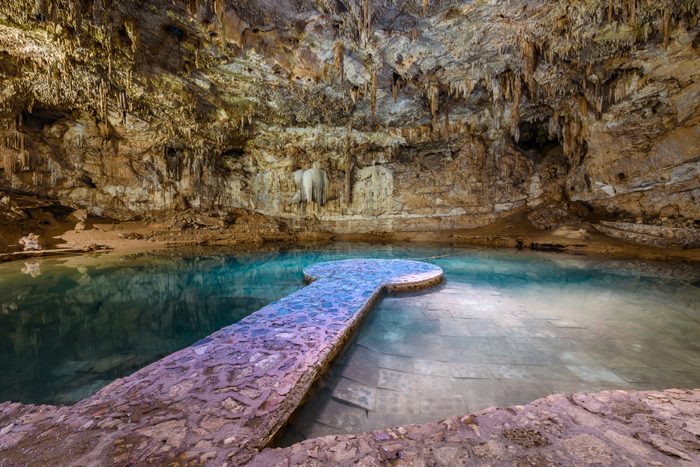
Suytun Cenote, Mexico
While most travelers head south of the border for the beautiful luxury resorts and sparkling blue waters, you’ll also want to venture out for a day trip to see this stunning natural wonder near Cancún. Located about 15 minutes from the colonial city of Valladolid, Yucatán, the underground cave has a stone walkway where natural light shines through a small hole—and creates the perfect photo op. There are bathrooms and changing facilities at the park, which has a small entrance fee.

Elephant Rock, Saudi Arabia
Jabal AlFil Elephant Rock is one of the ancient city of AlUla’s most recognizable natural sites: Wind and water erosion over millions of years created a massive elephant-shaped rock in the middle of the desert. It’s best to view this amazing rock formation during sunset, but dress warmly for cold desert evenings. And, in general, both men and women are encouraged to dress modestly and avoid tight-fitting clothes.

Northern Lights, Iceland
There are many places to view the northern lights (also known as the aurora borealis), and Reykjavík is one of them. Colorful streaks of light create striking rainbows in the dark sky, creating a photographer’s dream shot. Though it’s best to travel to Iceland between the months of April to August, the months of September and April are prime time for catching the dancing light show. Unfortunately, there isn’t just one location that offers optimal sightings. It also depends on the weather conditions, so it’s best to leave it up to the local tour guides to show you the best locations.
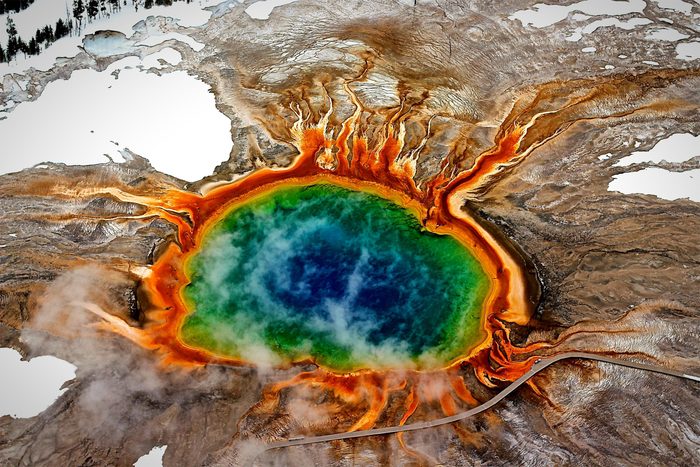
Grand Prismatic Spring, United States
Wyoming is home to many iconic natural wonders of the world, including Grand Teton National Park and Devils Tower National Monument, but it also has the world’s third-largest hot spring. The remarkable Grand Prismatic in Yellowstone National Park is the single largest hot spring in the park—it’s larger than a football field, so it’s hard to miss! A feast for the eyes, the rainbow-colored hot spring has a deep blue center and orange spider legs radiating outward. Avoid the crowds by climbing up the trail to an overlook on the nearby hillside; the 0.6-mile hike is worth the view.
Why trust us
Reader’s Digest has published hundreds of travel stories that help readers explore the world safely, easily and affordably. We regularly cover topics such as the best places to visit (and the best times to visit them), tips and tricks to zoom through airport security, flight-attendant secrets, hotel-room hacks and more. We’re committed to producing high-quality content by writers with expertise and experience in their field in consultation with relevant, qualified experts. We rely on reputable primary sources, including government and professional organizations and academic institutions as well as our writers’ personal experiences where appropriate. We verify all facts and data, back them with credible sourcing and revisit them over time to ensure they remain accurate and up to date. Read more about our team, our contributors and our editorial policies.
Sources:
- UNESCO: “Waitaki Whitestone UNESCO”
- Tahiti Tourisme: “Bora Bora’s Military History”
- Great Barrier Reef Foundation: “Climate change”
- National Park Service: “Sunrise”
- National Park Service: “Geologic Formations”
- Times: “Cappadocia’s hot-air balloon rides: everything you need to know”
- National Geographic: “What it’s like to live in the shadow of an active volcano”




















